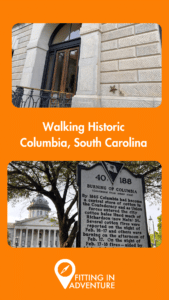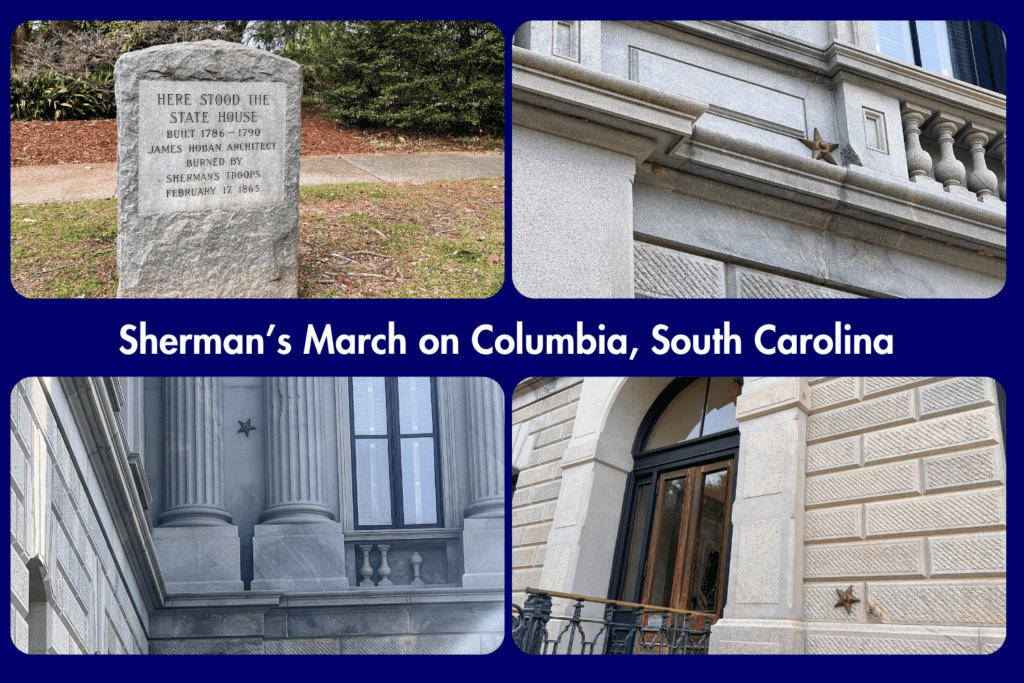Columbia, South Carolina, has the Postal Service to thank for its’ nickname. Postal employees would shorten the city’s name, Columbia, to Cola. This eventually gave way to calling it Cola. Which then morphed into Soda…hence Soda City! The city has since embraced it and ran with it. The new city shuttle system is dubbed the Soda Cap Express. Its logo is even a soda cap, which itself is a play on words. One because of the city’s nickname. And two, because Columbia is the CAPital city of the state.
Disclosure: Some links on our site are affiliate links. If you purchase a linked item, we will make a commission, at no extra charge to you.

Get to know Columbia, SC
- Founded in 1786, Columbia was the first city in the US to be named for Christopher Columbus. It narrowly beat out the other popular option; Washington.
- The city sits at the confluence of three rivers. The Broad. The Saluda. And the Congaree. This also gives it the other nickname of River City. But I think we can agree that Soda City is a little more fun.
- The first textile mill in the world to be run entirely by electricity opened here in 1894.
- Synchronous fireflies, or fireflies that all light up at the same time, are found in only a half dozen places worldwide. One happens to be right outside the city in Congaree National Park.
- Congaree National Park also has the tallest trees east of the Mississippi. Called “Champion trees”, these are trees that are the largest of their species.
- From the tallest trees to the largest dam. The Dreher Shoals Dam was the largest earthen dam when constructed in 1930.
- In downtown, Assembly Street stands out as a wide street at any time. But knowing it was designed this way in the 18th Century is unique. Local lore says this was because of the hope it was too wide for mosquitos to cross.
In some ways, Columbia is a relatively new city. At least in construction terms, but will get to that in a minute. It has the distinction of being the first planned city in the state. And the second planned city in the nation. The first is Savannah, Georgia. The original layout consisted of blocks laid out in a two-by-two-mile grid. In 1785, increased pressure from inland residents led to the State Legislature’s decision to move the capital. A committee found (as close as they could ascertain) the geographical center of the state. Thus, to the dismay of many residents of Charleston, the State capital moved to the new city of Columbia.
One stipulation of the move was streets must be at least 60 feet wide. The thought was the wide streets would aid in preventing diseases and fires. It was hoped that mosquitos would not be able to cross that wide a distance. Commissioners laid out the city as a two-mile square. The two principle streets would be 150 feet wide with the rest 100 feet wide. These would be ten streets per mile. This created 400 city blocks. Each is approximately 4 acres in size. These were then further divided into 8 half-acre lots. The newly constructed State House was positioned at the intersection of the two principal streets. These are named Assembly and Senate in honor of the legislature. All north-south running streets are actually slightly more northwest-southeast. This is to run parallel with the Congaree River.
History Behind Columbia’s Streets
The naming of the remaining streets was to honor important military and statesmen from South Carolina. North-south running streets east of Assembly are named for South Carolina’s Revolutionary War Generals. Those west of Assembly are named in honor of Continental Generals who fought in the State. East-west streets running north of Senate are named for statesmen and heroes. With the exception of “Lady”, which was named so to honor George Washington’s wife Martha. His “lady”. Those south of Senate are named for various well-known commodities of South Carolina. Tobacco, Rice, and Indigo, to name a few.
During the Civil War, South Carolina earned the ignominious distinction of being the first state to secede from the Union. And through most of the war, the state remained outside the warzone. So much so that important artifacts were sent here to preserve them. Valuable possessions were coming in from as far away as Georgia for safekeeping. This would prove to be a fateful decision towards the end of the war. General Sherman made his infamous “March to the Sea”. After leaving Savannah, everyone thought he would continue on to Charleston. Thus, many people from Charleston left for Columbia. Or sent their valuables there for security. But in mid-February when he turned his 20,000 men and 250 wagons towards Columbia, citizens realized it would be his next target. By then, it was too late.
Only a few stood in defense of the city. Most being brave citizens. They burned the lone bridge into the city from which Sherman could cross from his position. A single gun from one battery fired a few shots into the city from across the Congaree River. This was mainly to force a surrender of the city. A few shots struck the unfinished walls of the State House building. Today, six brass stars mark where damage was done to the building’s facade. Sherman ordered his troops north to cross the Broad and Saluda Rivers to enter the city. Once inside the city, troops burned and looted. Controversy still stands as to whether he gave the order. Or if it was pure wantonness from drunk soldiers. Nevertheless, the once beautiful and proud city was left in ash and ruins. Of the 124 blocks then occupied, 84 were burned completely. Due to this, most of Columbia was rebuilt following the war. Hence, making it a fairly young city in terms of construction.

The 28th President of the United States, Woodrow Wilson spent part of his youth here. His former boyhood home is both a museum to him and the post-Civil War Era. The house, completed in 1871, now houses a museum dedicated to one of the most misunderstood periods in American history. The museum is dedicated to the Reconstruction Era following the Civil War. In the context of Columbia in the 1870s, it educated on how the 9,297 residents navigated the political, social, and economic changes of the times. A time when African-Americans participated in government. Received access to education. Founded churches. And negotiated new labor terms. Many prominent African-American leaders are highlighted. Charles M. Wilder who was one of the first to be appointed a postmaster. And Richard Greener, the first to graduate Harvard and the first black faculty member for the University of South Carolina.
The museum offers the opportunity for visitors to engage in meaningful conversations about citizenship over the last 150 years. Their Citizenship Center prominently displays the 13th, 14th, and 15th Amendments. Alongside these are provocative questions to inspire meaningful conversations.
Much has changed in Columbia since it was first founded in 1786, but much remains the same. Southern charm is alive and well. Magnolia trees bloom in the spring sun as students walk between classes.

